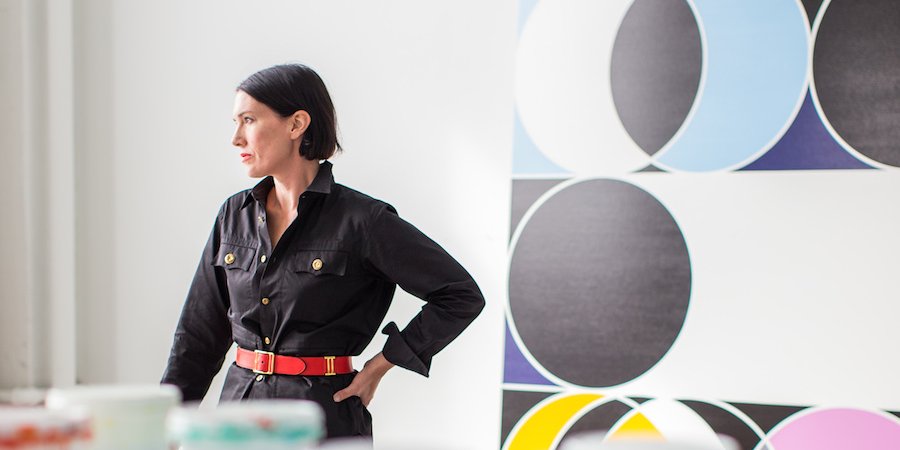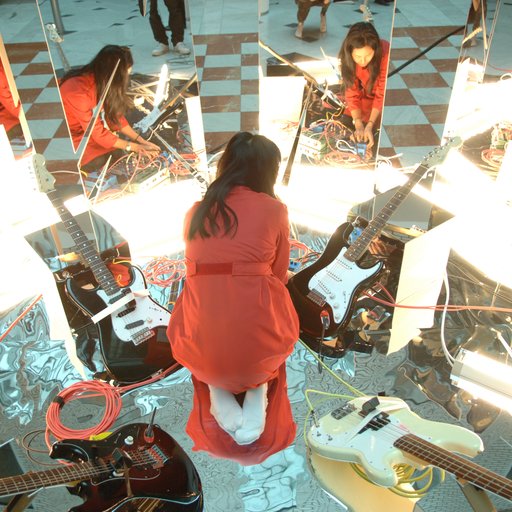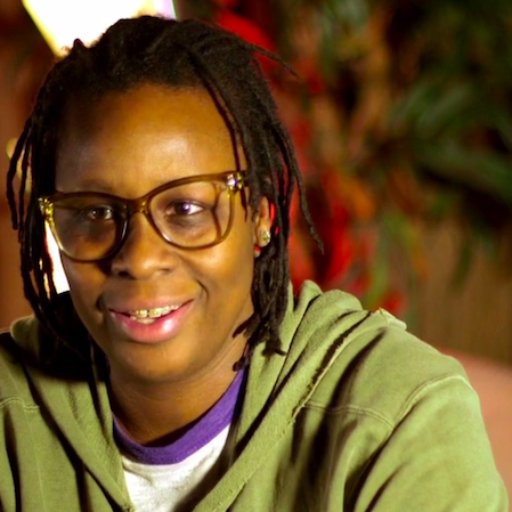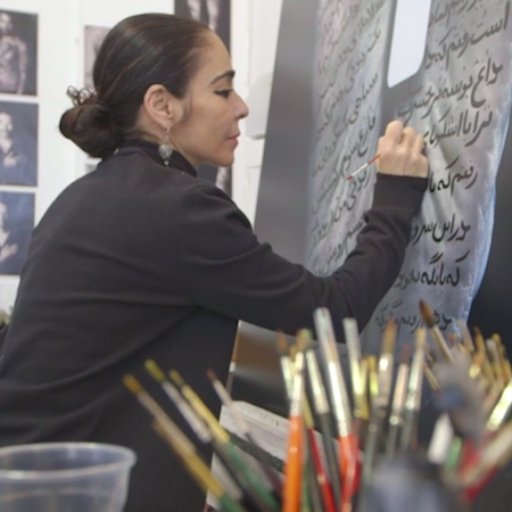Super-sized egos, government bureaucracies, and major corporations have a way of stifling creativity, but not for the artist Sarah Morris . In her colorful, grid-based paintings and episodic films of urban architecture, the longtime New Yorker has probed powerful systems and structures of all kinds.
For her 2008 film Beijing , she sought—and obtained—permission to film at that year's Summer Olympics from the International Olympic Committee and the Chinese government. Earlier, working with the Public Art Fund in 2006, she covered the lobby and courtyard of New York's landmarked Lever House skyscraper with her sprawling mural Robert Towne (named for the Hollywood screenwriter). Her latest film Strange Magic, commissioned by LVMH for the opening of the Fondation Louis Vuitton in Paris, is similarly ambitious and perhaps even rangier in its scope; it explores the construction of the controversial Frank Gehry -designed museum in the Bois de Boulogne, gives us a portrait of Gehry himself, and goes deep into the mysterious workings of the luxury conglomerate.
The film can be seen this week in the “Unlimited” section of Art Basel ; Morris's paintings will be shown elsewhere in the fair, along with a short film about her by her friend Anna Gaskell . (Titled Echo Morris , it centers on Morris's 2011 legal skirmish with a group of origami artists who sued her for using their designs in her paintings—an episode that resulted in a settlement and, in a way the plaintiffs probably never intended, dovetailed with larger themes of ownership and control in Morris's art).
When Artspace visited Morris's immaculate Long Island City studio earlier this month, the artist—looking stylishly severe in a uniform-like black ensemble with a red belt that matched her lipstick—was getting ready for Basel while also working on paintings, researching her next film, and preparing for a solo exhibition that opens in October at the Museum Leuven in Belgium. She spoke to Karen Rosenberg about going behind the scenes of LVMH, why it takes a conspiracy to build a museum, and what she's learned from her former boss Jeff Koons .

From the beginning of your career, you’ve been making films and paintings. How do you go back and forth between the two mediums?
The films and the paintings are constantly both always going on. They’re very much two sides of the same coin. When I was talking about the films as a set of coordinates, or situations, the paintings also are a set of literal coordinates. It’s not that it’s about architecture; when I make a painting called Paine Webber with neons, it’s nothing as literal as a painting that’s depicting that place and time. What it’s doing is creating a rhetorical device, a virtual architecture. Some of the titles refer to places that are no longer in existence. Paine Webber is no longer in existence; it’s now UBS. The paintings, for me, are like a retinal after-image of a set of virtual places.
It’s important that people understand the paintings came first, and film came after as a way to create this index of people, places, things—a set of references for the paintings.
How would you compare your latest film, Strange Magic , to your previous films? Some of them are focused on a city, like Los Angeles or Beijing , and others, like Robert Towne , are more focused on a person.
I was interested in this mash-up between architecture, fashion, finance, and nationalism, and also the context of the Bois de Boulogne and the history of France. I was curious to learn about this history, within the company, of all of these different products and things—people associate it mainly with fashion, but there’s a number of other products they’ve appropriated along the way. One is champagne, another is perfume—all very intense French symbols. Strange Magic is a portrait of contemporary France, a portrait of the Bois de Boulogne, a portrait of the capital flow going into the building.
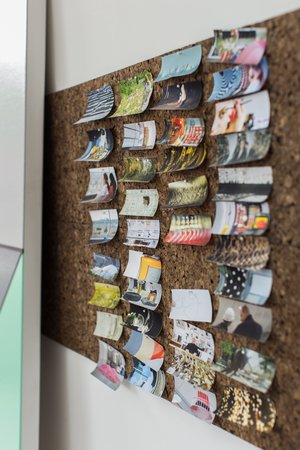
You’re creating that portrait with a lot of behind-the-scenes imagery from the various LVMH industries—exploring the processes of champagne and perfume production, for instance.
It was definitely the first time they had ever let anybody go into the factories and film. Which is curious to me, because these are alchemical processes but they’re also industrial and they’ve been around for a long time. For instance, when you see the perfume scenes, that distillery in Grasse, in the south of France—that’s the company that does all the distillation. They work for a number of companies but mainly for Dior. That process of steaming, getting the oil out of a flower, that’s obviously beyond any brand. The architecture that I show, that strange phallic distillation machine, has been around for hundreds of years.
These things are beyond any one individual—they become cultural icons, and cultural processes, and the processes can go elsewhere. They’re not necessarily regional, but somehow we associate them with France.
So you’re trying to show how these artisanal processes become incorporated, or “appropriated,” as you say, into a collection of luxury brands?
Taste and luxury are extremely flighty things, very difficult to pin down. What you’re really consuming is not the thing. It’s actually some weird dream around the thing. It’s not even the brand. It’s this weird dream about a future self. When you think about having several glasses of champagne, it’s not about the brand or the opening of the bottle but the state of mind that you’re in. It’s this idea of what you’d be doing while you’re consuming these things. It’s a very strange dream that they’re spinning, and it changes every decade. It’s not really clear what it is that they’re selling.

The film is also about Frank Gehry, the architect of the Fondation Louis Vuitton and one of several architects to appear in your films. What drew you to him, besides the LVMH commission?
I’ve always been interested in him because of his relationship to certain artists I’ve liked in Los Angeles. His home in Los Angeles, the way it’s been added onto year after year, defies any idea of a conclusion. I think that’s really interesting to think about, as an artist—that what you’re doing is a series of gestures that are creating an amalgamation, or a continuing process. I’m creating a series of images, or paintings, that are not resolved—they’re splintering and becoming another painting, a larger space. There’s something in Gehry’s work that’s akin to that process.
Gehry’s buildings are notoriously difficult—difficult to apprehend, to maintain, to show art in.
Are they difficult? I live in a Paul Rudolph building, so the idea of “difficult”…. If you start looking at a Rudolph building, you wonder: How do you clean it, how do you maintain it, how do you not fall over and die? I don’t know if Gehry’s work is really that difficult.
It’s very difficult to repeat, and we’re used to architecture that can be copied—that can become a school. His work is so technically idiosyncratic and one-of-a-kind that it’s not really possible to copy it.
He’s a “starchitect,” with all the power and singularity that implies.
I really hate that word. I’m sure he hates it too. Because if you know some of these people, it’s more like, yeah, you stick to what it is you want to achieve and you get a bad reputation in the process, because you’re simply trying to follow your vision. People think you’re impossible when you try to do that. It goes for artists too, film directors, musicians. I think that term is more suited to the consumption of the thing.

Despite Gehry’s stellar international reputation, the building of the Fondation generated some controversy in France. Critics objected, in particular, to the setting—the placement of a private museum in a public park, in the storied Bois de Boulogne. How did you address that in the film?
Frank had mentioned Proust a lot, and I definitely thought about the idea of this city allowing a new museum to be built in the park—it’s pretty historic. What’s going on in the park is extraordinary too. There’s this medieval trade (if you want to call it that) and a children’s garden, so these very strange worlds collide. The site for the museum is really interesting—it seems simultaneously very far away from Paris and also smack in the middle. And it does just sort of grow up out of seemingly nothing. I mean, if it was on a busy block in the Marais you wouldn’t have the same type of epic-ness of it being situated in the gardens, in the park. Being able to pull off making a museum like that—to have the ego to do it is one thing, to have the ability to get it through is another.
You’ve said that your previous films are about conspiracies, or “the city as conspiracy.” Is that true here?
There’s definitely something super-conspiratorial about it. I can’t outline all of this to you, but, absolutely. Conspiracies can be good and bad. All conspiracies aren’t, like, killing JFK. And I mean “conspiracy” in the widest sense of the word—it takes a push from a number of key players in order to make something happen. It’s the same with art, architecture, legislation. It takes a conspiracy to build a museum.
I am really intrigued by the set of the different brands that were accumulated, because it’s very different from how it is in America. The idea of creating a set of companies that actually meld in the public consciousness with the country is very specific, and I don’t know any other company that has done that. It’s so quintessentially French. It’s so old, so entrenched, and that collective unconscious is so deep, that your company becomes like a government. A statuesque woman in gold becomes the Eiffel Tower, and back again to perfume.
I think this film more than any of the others goes from city to nation, to that entire collective unconsciousness about what is luxury, what is taste, what is this ephemeral thing that’s making us consume the way we do.

What about the cultural and political climate of contemporary Paris, the clashes and crises that have been chronicled in recent headlines— Charlie Hebdo and so on. Does a sense of anxiety come through in the film?
It’s absolutely a portrait of modern France, with all that that implies.
It could be about the idea of patronage, of capital becoming a museum. The architect could be a stand-in for the artist. In this particular case Gehry is extremely well-versed in handling the entities, whether they’re national entities, museum entities, corporate entities. He talked to me a lot about Disney. As an artist, you’re dealing with that too. I’ve not only been asked by people to do certain projects but I’ve also placed myself in positions where I’m dealing with the Chinese government, or the film industry, or origami—you’re dealing with some other entity and you have to negotiate that.
Speaking of dealing with powerful entities, did you encounter difficulties with access in the making of this film? How did it compare, in that regard, to previous films like Beijing , where you had to seek permission from the International Olympic Committee and the Chinese government?
All of the films are, at times, difficult to make. Take Los Angeles , for example. Out there, the ego thinks it’s a corporation. The ego becomes the nation-state. When I was filming that, and working on those paintings, I decided I was going to shoot in Beijing—which has other problems. There is no face to the organization that is the Olympic Committee. And then you’re dealing with the Chinese government, which would just say to me, “yes, yes, yes,” but actually yes clearly meant no. Whereas in L.A., nobody says no and they probably mean yes but it’s all up in the air and you can’t figure out where you stand.
As an artist, when you want to place yourself in a certain situation, people get very worried about being somehow exposed. What are you going to do with these images, how are you commenting on them? There’s a certain level of trepidation, and usually there are people involved that calm everybody down and somehow persuade them that it’s going to be ok. I think this happens with all the films.
Was this more difficult? In some ways, it was very difficult because of the level of control and fastidiousness involved in this particular institution.
Even though the piece was a commission from the institution?
That was the irony of it! I felt that I had been given the key to the institution, therefore I should be able to run amok. But of course, it isn’t as ideal as that. You have to keep negotiating. Once you’re inside, once you’ve infiltrated, you still have to get to the top floor.
The architects have a lot of experience with this, and they have to deal with it much more—this whole negotiation thing. They court it more, by the very nature of what they do. It was very interesting to see how Frank Gehry negotiated with this entity, even right up to the end—even up to the opening night of the museum.

How has your filmmaking process changed over time?
The films have become more ambitious, for sure, and more sophisticated, with lenses and hard drives and all the rest of it. But it’s the same modus operandi, which is to try to use reality—all of the films are very much cinema verité—and let that unfold. I don’t think there’s really any need for fiction.
The first film I did, Midtown , in 1998, was shot in one day using a news crew. I had very specific places, coordinates, where I wanted to film. That process hasn’t changed—there’s a set of coordinates, there’s a set of times, there’s a set of images that I want to capture, and whatever happens to be there when I’m shooting is what I’m going to shoot. Of course there’s editing involved, but that in essence is what it is. So we show up in Bois de Boulogne—that’s what we found. I did not give the prostitute a little bear sweatshirt—she or he had that, and that was there. The modus operandi hasn’t really changed at all, but the width of the subject matter has expanded.
The same issues of potential trespassing were in Midtown , as they are in Strange Magic . With Midtown , we were filming things like Chase Bank, Alliance Capital, UBS—some of the things that are the titles of my paintings. The news crew told me, “Sarah, there’s a little brass line on every sidewalk in New York, which demarcates private corporate space and public space. You can’t go on the other side, but the lens can.” That has stuck with me ever since—you can be outside, but everything you can see is public space.
Are you planning to make another New York film anytime soon? The city has changed so much, and the expression of power through architecture—the main subject of your films—is so apparent in the super-tall skyscrapers going up in midtown Manhattan.
I have thought about it a couple of times. There’s a little bit of that in Points on a Line —I ended up going to the Four Seasons in the Seagrams building, just because that’s where I originally met Philip Johnson. I would love to make a piece again in New York. The topography, on many levels, has changed.

Let’s talk about some of your formative influences. You were an undergraduate at Brown University in the late 80s, at the height of theory-mania. How did that shape you?
I definitely read a lot of books. I love reading philosophy, I love reading fiction. Although I certainly didn’t have any money to make film as an undergraduate, I was aware of what was being made and this connection between theory and production—it wasn’t enough to just be reading. That was an absolute position I had, from very early on.
I also studied political philosophy, so I wasn’t just reading cultural or film theory. But it was always clear to me that making films, or making paintings, or being an artist, was the only choice I had. And then I was invited by Hal Foster to apply to the Whitney [Independent Study] program, and at the same time I had done a manifesto, "DEFUNCT!," the last year I was at Brown, which was a one-shot publication—I edited that with a friend of mine.
Through that process, I met Jeff Koons. I needed a part-time job, and that was before he had a proper studio—he was really working in Europe, at the time. He had just finished doing the “Banality” show, and I helped him with the “Made in Heaven” series. That was very formative!
What did you learn from Koons?
There was Whitney program and then I would get on my bike and go over to Jeff’s house. People thought this was outrageous, because it seemed to be the antithesis to this other position. I didn’t see it that way. In my worldview, it was harmonious.
I saw a very defiant spirit who definitely wouldn’t take no for an answer. That, I learned from him. I also learned to be very independent and autonomous, to try not to rely on galleries, to keep your distance and keep it separate—don’t get everything all mixed up.
That’s interesting, because your art is very much about compromising or complicating autonomy—ensnaring the viewer in a larger, overwhelming structure.
When you look at a series of mine you get this feeling of the pieces going past the canvas, mainly because of the seriality and the splintering effect and the repetition of certain colors or forms or shapes. There’s this unfolding that goes on, where one piece can generate the next piece. The next thing you know you’re in Lever House, the next thing you know you’re in Paris.
You're somehow encompassed in a system that is larger than you, where you realize that you are absolutely part of this system, that there is no inside and outside. That you’re part of it, and that you are complicit. The question is where to go once you accept that.












